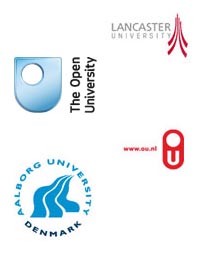

Designing for Learning in Coupled Contexts
Janne Gleerup, Simon Heilesen, Kevin Mogensen, Roskilde University, Roskilde, Denmark
Vocational training curricula are often designed as a progression of alternating periods of attending school and working as an apprentice in a company. In the case discussed in this paper, involving the training of electrician apprentices at a Danish vocational school, many of the apprentices (pupils) have difficulties understanding how the two modes of learning, i.e. formal learning by means of instruction and informal learning through apprenticeship, relate to one another and add up to a meaningful whole. This paper is an account of an experiment in designing for net-based vocational learning with the aim of providing a coupling between widely different learning contexts. The design approach is based on a user-focused quadruple helix model of understanding the learning situation. According to this model, knowledge institution, enterprise, and public authorities together and in shifting constellations provide a framework in which all actors assume roles that are multi-dimensional. The actual design process used is based on a recently-developed method for user-driven innovation, the "quadrant model", involving apprentices, teachers, and masters and journeymen from companies as active and equal co-creators of new didactic designs. Having initially acquired domain knowledge by means of observation and interviews with the various user groups, the researchers together with apprentices, teachers, masters and journeymen have developed a series of designs for new practices by means of workshops, prototyping, and testing. The final outcome has been three designs that facilitate communication between apprentice-and-apprentice, school-and-apprentice, and apprentice-and-master/journeyman. From the perspective of the apprentices, the three designs: a) facilitate community building; b) help bring the school into the practice environment; and c) encourage reflection on one's own practice. From the point of view of the school, the designs make it possible to extend formal learning to the workplace, and for masters/journeymen the designs offer an opportunity to supplement dreary routines of documentation with visualisations and reflections on practice. It is suggested that the designs are likely to result in an empowerment of the apprentices, and thus that in a wider perspective successful integration of the designs entail a need for adjusting existing practices in terms of assigning the learners a more active and responsible role as co-contributors to their own education.
Keywordscoupled learning contexts, didactic design, practice-based research, quadruple helix model, quadrant model of innovation, user-driven innovation, work-based networked learning
| About NLC | Welcome Messages | 2012 Conference Proceedings | Conference Organisation |Invited Speakers |Proceedings Handbook | Past Conference Proceedings | Exploring the Theory, Pedagogy and Practice of Networked Learning |Contact |